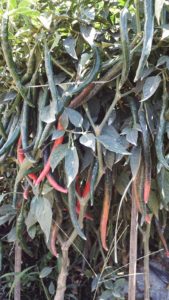Taking care of your chili crops properly is the key to productive and continuous harvest. The core caring for your chili crops are watering, weeding, and fertilization. However, plastic mulch and pole markers are also important in this part.
- Pole Markers
Pole marker is very useful for your chili crops. It’s usually made of bamboo cut into 80-100 cm pieces then stuck in the middle of your chili plants. Here are the benefits of using pole markers:
- As a prop for your plant to stay sturdy. On young or new plants, it is especially important to train them to stay sturdy where they are.
- As a prop for chili plants during heavy rain and wind or insect attack and other extreme conditions.
- To keep your chili plants to grow straight upward and not bent.
- To keep your plant’s function optimum.
- To optimize nutrients’ flow from roots upward.
- To make photosynthesis happen faster because your chili plants will be directly under the sun.
- Plastic Mulch
A lot of modern farmers worldwide has attested to the benefits of using plastic mulch.

Using plastic mulch has been proven to help farmers in upping their crops’ productivity.
Here are the benefits of using plastic mulch:
- To stabilize soil’s humidity and avoid dryness.
- To keep planting medium (soil) quality in top condition by keeping nutrients accumulated in one area under the mulch thus allowing proper distribution and absorption of nutrients from soil to roots to other organs even during rainy season.
- To keep pests out. The mechanism is more or less like this: during the day when the sun shines strongly, the light will be reflected by the plastic to the plants thus allowing UV light to kill dangerous pathogenic diseases. For maximum effect, silver plastic mulch is most recommended.
- To help prevent soil erosion during high precipitation.
- To keep the structure of your seedbeds.
- To keep your plants to grow uniformly.
- To help accelerate fruit production in good amount and condition.
